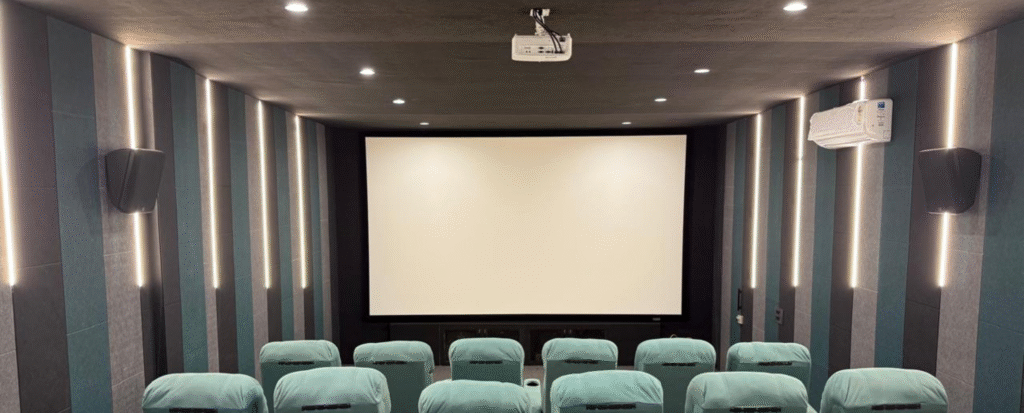COMMERCIAL CINEMA SOLUTION

Instruments Used in Commercial Theatre
Commercial theatre relies on various instruments to enhance performances and engage audiences. This detailing explores key instruments, their roles, and their impact on theatrical productions.
Types of Theatrical Instruments
Musical Instruments: Instruments like pianos, violins, and drums create live music that enhances the emotional quality of performances. Their presence adds depth to storytelling and creates a unique atmosphere for each show.
Sound Equipment:
Microphones, speakers, and mixing boards are essential for amplifying voices and sounds. They ensure that all audience members can clearly hear and enjoy the performance, regardless of the theatre’s size.
Lighting Instruments:
Spotlights, LEDs, and projectors create mood and focus attention on actors. Proper lighting helps to set the scene, indicating changes in mood, time, and space throughout the performance.
Stage Effects Equipment:
Fog machines, pyrotechnics, and other special effects contribute to the visual spectacle. These devices engage the audience’s senses and heighten the emotional impact of crucial moments in the play.
The Role of Music
Enhancing Emotion
Music evokes feelings and sets the overall tone of a production. Composers craft scores that align with the narrative arc, guiding audience emotional responses at key moments.
Character Themes:
Musical themes associated with specific characters can aid in storytelling. These motifs help audiences connect with characters, making their journeys more relatable and memorable.
Transitions and Scene Changes:
Music can smooth transitions between scenes, maintaining momentum and keeping audiences engaged. It directs attention and provides cues for changes in time and space on stage.
Sound Design in Theatre
Sound Effects:
Specific sound effects create realism in performances, from natural sounds like birds chirping to urban noise. They can transport audiences into the world of the play, enhancing immersion
Background Ambience:
Ambient soundscapes establish mood and context. For instance, background noise in a café scene creates a lively atmosphere, enriching the storytelling experience.
Balancing Sound:
Sound designers balance live performances with recorded music and effects, ensuring clarity. This balance is crucial for maintaining the integrity of dialogues and musical performances.
Lighting Techniques
Key Lighting:
This is used to highlight actors and essential elements on stage. Techniques like backlighting and sidelight create depth, enhancing visual storytelling.
Color Usage:
Different colors evoke specific moods; for example, warmer tones may suggest happiness while cooler tones can create a feeling of sadness or tension. Strategic color choices contribute to the overall aesthetic and emotional impact.
Gobo Projectors:
These create patterns of light and shadow that add texture to performances. They can represent elements like trees or cityscapes, providing visual interest and context without physical props.
Special Effects in Theatre
Fog and Smoke Effects:
These add atmosphere, creating an air of mystery or drama. They can be used to convey dreams, flashbacks, or other thematic elements that enhance storytelling.
Pyrotechnics:
Carefully orchestrated special effects, like small explosions, add excitement and spectacle. When used safely, they can elevate key moments and captivate audiences.
Automation:
Moving platforms and automated set pieces offer dynamic staging possibilities. This technology allows for seamless transformations within scenes, enhancing the visual storytelling aspect.
The Future of Theatre Instruments
Integration of Technology:
Advancements in technology, such as virtual reality and augmented reality, are being explored in theatre. These innovations can offer new experiences, blurring the lines between live performances and digital media.
Sustainability Trends:
As environmental concerns rise, there’s a push for sustainable instruments and production practices. Theatre companies are adopting eco-friendly technologies and materials to minimize their environmental footprint.
Audience Interaction:
New instruments and technologies are enabling greater audience participation. Interactive elements lead to unique performances where audience responses can influence the outcome.
Conclusion
Instruments in commercial theatre play vital roles in creating immersive experiences. From music and sound design to lighting and special effects, these tools collectively enhance storytelling, evoke emotions, and connect audiences with performances, shaping the future of theatre.

